

? | Home page | Tutorial | Recording




Before anything else, we need to prepare the recording session. We are not going to look for a melody, nor improvise or rehearse... we are going to properly record a song that we have already written. To avoid doing the same things over again each time I wish to record a song, I prepared a blank template which contains all the tracks and buses I need. I may naturally add or delete some elements if the template is not appropriate for the current project.
What does my template look like?
Track-wise:
- Rhythm guitar tracks (from 2 to 8 depending on the project)
- Solo guitar tracks (usually 2 tracks to make the sound thicker)
- Two bass tracks (one with the direct raw sound, and one with an amp simulation)
- Lead vocal tracks (usually one or two tracks, depends if I record it twice or not)
- Background vocals tracks (if the project demands it)
- Keyboard tracks (same thing, the number of virtual instruments will depend on the project, can be none, can be 5 or 6...)
Then we have drum tracks. There is one track per drum element. They are automatically created when I insert my virtual drum plugin:
- Kick drum
- Snare drum
- Low tom
- Medium tom
- High tom
- Hi-hat
- Crash cymbal
- Ride cymbal
- Splash cymbal
- Overhead microphone
- Room Ambiance microphone
- Piezzo microphone
- One MIDI track on which the drum score will be placed.
Bus-wise, I have one group for the guitars, one for the bass, one for the vocals, one for the drums, each of them is redirected towards the Master bus, which goes out throuh my studio monitors. It looks like this:

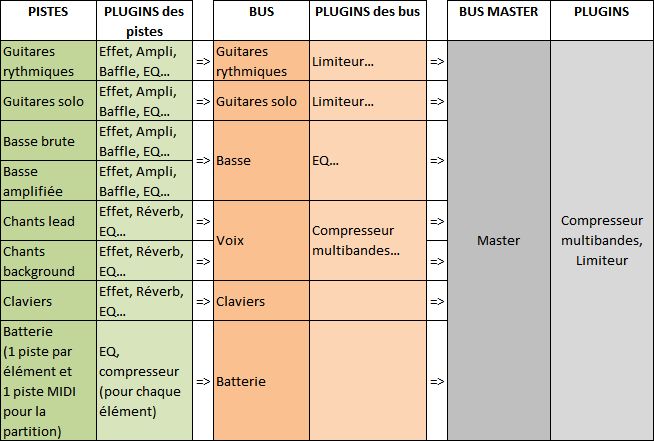





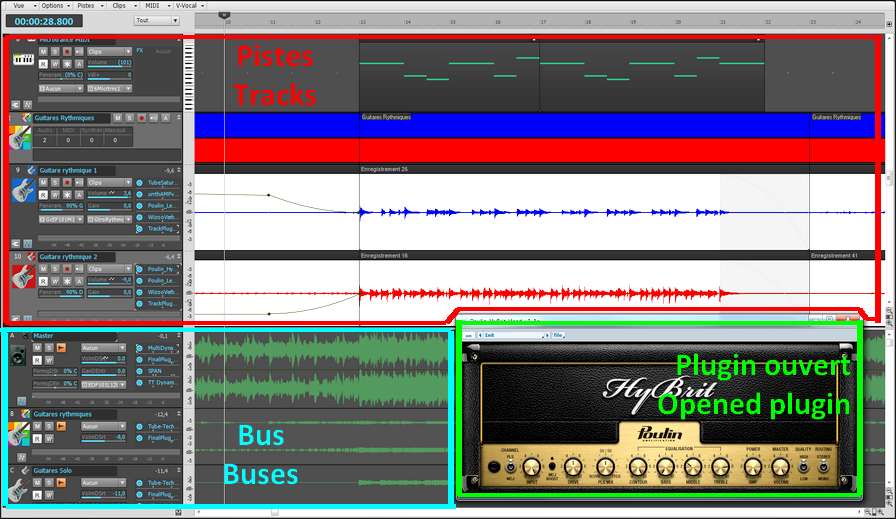


Recording an acoustic real drum kit is far from being easy, even for professional sound engineers. It a time-consuming process, it's frequent to spend several hours placing the microphones around the drum elements before you can actually record. But we are in a home studio, and we will have to deal with a software drum kit, based on midi files...
First of all, why start with the drums? The answer is simple, we will use drums as a metronome. The drums sound will guide us and help us follow the tempo. This will allow for an even recording and the song will not speed up or slow down unintentionally. Of course, variations can be interesting and bring some life to an otherwise mechanical tempo, but let's consider that a studio session seeks recording perfection, even though it's only a home studio.
I usually have no idea what my final drum track will sound like. Actually, I only adjust it when the rest of the song is finished. But I still need its metronome function to record all other instruments. Thus, I create a drum track which repeats itself over and over again, and I try to have this loop match what I am about to play (no punk rhythm to record a ballad). For instance, I'll use one of these patterns:
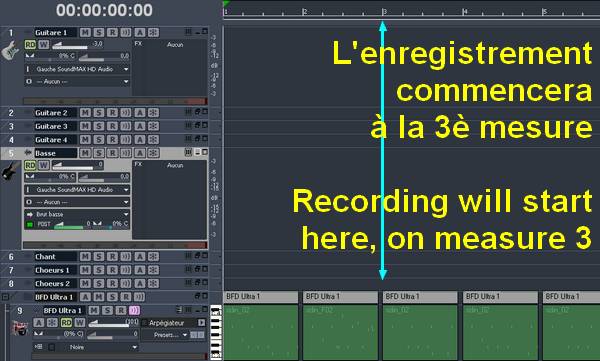

Let's not forget we are recording in a home studio, in an appartment and it is simply impossible to play with a good old 100-watt tube amplifier, without the neigbors calling the police. So we are going to have to record the guitars and the bass directly through the audio interface. No real amplifier, no microphones involved. The latter solution would be preferable, but on of the benefits of direct recording, coupled with amplifier simulators, is that you can always edit the sound later, without having to re-record. Just change the settings and you're done.
So now... bass or guitars first? There isn't one clear answer. Bass and drums are the foundation, the rhythm base of a song and everything else should rely on them. But other factors could also be taken into consideration: for instance, the person recording may be more comfortable with a guitar than a bass, and will rather play guitar first. Or maybe the song has a very important bass riff that compels you to record it first. In any case, you are the one who can decide. If you are uncertain, then the drum / bass duo is a safe bet. If this is in place, then the rest can easily be added.
Guitar or bass, the recording process will be the same. Plug your guitar into the pre-amp, the pre-amp is connected to the audio interface (or plug your guitar directly into the audio interface if using the interface's pre-amp), and set the recording level. This is very important! Before recording anything, check that you are not going to go beyond the maximum level (0 dB, zero decibel). In a home studio, you won't have a sound engineer besides you to make adjustments on the fly, while you are playing. You are the one to take precautions. How can you do that? Simple: try and adjust, it doesn't take long and will prevent you from making a perfect take, then realize the levels were too low or too high, forcing you to do it all over again.
Have a try: for a rhythm guitar for example, play the loudest parts and set the preamp and audio interface volume levels in such way that when you play the loudest, the recording level doesn't go beyond -6 dB. The absolute maximum that you should not reach or go beyond is zero dB. If you play in your try the same way you play during the actual recording, then you can be certain the recording level will be correct. If your average level is between -9 db and -6 dB, then your level is sufficient and you have a margin of error before clipping.
Clipping is the term used to indicate that you reach or go beyond 0 dB. Clipping is your enemy :-)
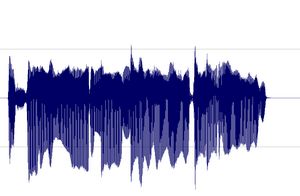
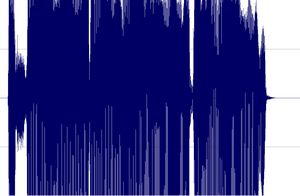
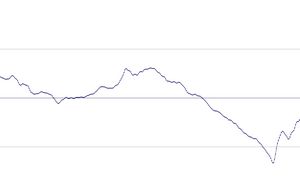
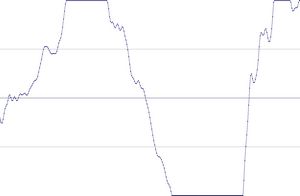

I prefer to record them last but there are no rules. If you prefer to record them first, then do so.
To record vocals, make sure the place is quiet, shut the door, tell the people who live with you to be quiet, and do not record while your neighbor is drilling holes through his kitchen walls! Also, turn off your monitors and use a headset instead to avoid recording the playback with your microphone.
Condenser or dynamic microphones?
Dynamic microphones are solid, they don' need a power source, they can take heavy acoustic pressure (like a kick drum or a saxophone) and they are not too expensive. They are also less sensitive to surrounding noises than condenser microphones. The cons are they lack clarity in the high range, which renders takes less clear and defined than with condenser microphones. They can be used with Jack or XLR plugs.
Condenser microphones are much more responsive and accurate. Their high sensitivity is double-edged, because they will capture any noise when recording. The fans of your PC are noisy? Chances are this noise will be recorded. Sound comes out of your headset? It will be recorded by your condenser microphone. Children are loudly playing outside? You might get that too. However, some condenser microphones are called "cardioid", or "hyper cardioid", and they only record what comes from a specific direction, ignoring (more or less) other sound sources from other directions. On the contrary, omnidirectional microphones record what comes from anywhere. Not ideal for a home studio. Condenser microphones are also more fragile (don't knock them) and must be powered through a "phantom power", whose standard is 48 volts. This kind of power is either present on your audio interface and can be turned on and off with a button, or it will require the use of an external phantom power source that you will then connect to your audio interface. You have to use 3-pin XLR plugs that carry the phantom power current. Finally, condenser microphones are usually rather expensive, some of them cost several thousand euros (or dollars, or pounds), but only professional studios or rich amateurs can afford those. On the plus side, the sound you get with a condenser microphone will have the best quality.
Be cautious though, a good dynamic microphone is worth better than a bad condenser microphone. No big secret here, for microphones like for anything else, very low prices are rarely synonymous with good quality.
A few known and renowned microphone brands: AKG, Milab, Neumann, Rode, Sennheiser, Shure...
Some pieces of advice: buy a microphone stand and a pop filter (you can also make one yourself with wire and a piece of tights from your wife / girlfriend / mother / daughter / neighbor). The stand will prevent you from manually holding your microphone and thus produce handling noises. As for the pop filter, it prevents the air to hit the microphone and produce unwanted blowing sounds when you pronounce some letters such as "p" or "b".
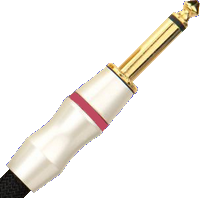
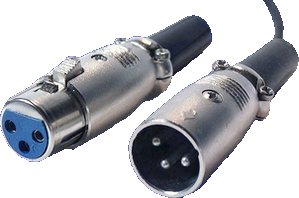
Jack plug (left) and XLR (right)
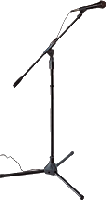


No need to go on and on forever, recording is rather easy. As long as you pay attention to your recording levels and take care over your takes, you should get a satisfying result, good enough to finalize the song

Messages page # 1 2 3 4 5 6 7 8 9 10 11 12 13 14 15 16 17 18 19 20 21 22 23 24 25 26 27 28 29 30 31 32 33 34 35

FENDER VG
le 12/04/2016 à 06h51
Bonjour,
J'ai des voix à enregistrer sur une bande son, jusque-là je sais faire. Mon souci, c'est le bus d'écoute de chaque chanteur.
J'ai inséré un bus aux sur lequel j'ai routé mes différentes pistes à enregistrer ainsi que la piste de la bande son. Ensuite, j'ai routé la sortie de mon bus AUX sur le Master quand j'agis sur le potard d'AUX de n'importe quelle piste, rien ne se passe, le son reste pareil alors que moi je voudrais que chaque chanteur puisse avoir son propre mix dans les oreilles.
Pourriez-vous m'aider, merci d'avance.
* * * * * * * * * * * * * * * *
<em>
Bonjour,
Pour que chaque chanteur puisse avoir son propre mix, outre le fait que chacun ait son propre casque bien entendu, il y a deux solutions.
1 - La plus simple est d'utiliser un préampli casque à plusieurs canaux. Cet ampli se branche sur la prise casque de l'interface audio, et dispose de plusieurs branchements pour des casques. Il faut donc choisir un préampli disposant de suffisamment de canaux (plusieurs prises casques).
Avantage : très simple à mettre en place et pas très cher pour un modèle de base.
Inconvénient : chaque chanteur entend le même mix. Vous ne pouvez régler que le volume individuel, et éventuellement l'égalisation si le préampli le permet, mais vous ne pouvez pas régler le niveau des instruments qui composent le mix.
Je possède un préampli permettant de brancher 4 casques, avec réglage de volume pour chacun, il s'agit du Behringer HA400. Petit boîtier très simple et qui marche très bien, qu'on trouve facilement sur Internet entre 25 et 30 euros.
Toujours chez Behringer, le modèle HA4700 Powerplay Pro-XL, toujours pour 4 casques, permet de régler l'égalisation individuelle de chaque casque, mais il coûte entre 120 et 130 euros.
Et si vous avez besoin de plus de 4 casques, vous en trouverez à 8 canaux par exemple, mais là aussi, il faudra compter plus de 100 euros, selon les marques et les possibilités. Je vous laisse regarder les différents modèles qui existent.
2 - Pour avoir un mix vraiment différent dans chaque casque, il va falloir utiliser les sorties audio de votre interface audio. Il faut donc une interface avec de nombreuses sorties.
J'ai trouvé l'article suivant qui détaille un peu plus tout cela : <a href="http://www.jeuxdecordes.fr/2011/10/repeter-au-casque-avec-son-groupe/" target="_blank">Répéter au casque avec son groupe</a>
Grebz
</em>

cobhc83160
le 06/04/2016 à 18h37
Bonjour,
Tout d'abord je tiens à dire bravo, excellent site !!
En revanche, je ne sais pourquoi mais chez moi je n' arrive pas à utiliser les simulateurs d'ampli :(
Je prends par exemple LeCab 2 de Lepou avec lequel je charge un des sons pris sur votre site, par exemple le Mesa Boogie Studio 22.
Puis j'utilise la tête Lepou Legion... et là je ne sais pas pourquoi, aucun son ne sort :(
Je suis sur Mac avec Logic Pro X.
Ai-je loupé quelque chose ?
* * * * * * * * * * * * * * * *
<em>
Bonjour,
Je vais essayer de vous aider, mais je suis sur PC et pas sur Mac, alors il y a peut-être des choses que je fais qui fonctionnent différemment sur Mac... Normalement, non, mais on ne sait jamais.
Pour que cela fonctionne, il faut mettre au moins les éléments suivants sur votre piste de guitare, dans cet ordre :
- Un simulateur d'ampli, pour simuler la tête d'ampli. Par exemple le simulateur LE456 de Lepou.
- Un chargeur d'impulsions pour simuler le cabinet (le baffle, le haut-parleur), comme le LeCab2 de Lepou, ou bien le NadIR d'Ignite Amps.
- Dans le chargeur d'impulsions, charger l'impulsion de votre choix, qui est un petit fichier audio au format Wav.
Vérifiez bien que vous avez les versions Mac des simulateurs d'ampli et du chargeur d'impulsions, évidemment !
Ensuite, pour les impulsions, on utilise des fichiers au format wav sur PC, mais j'ignore si c'est la même chose sur Mac. Est-ce qu'il ne faudrait pas des formats AIFF, ou autres ?
Dans le chargeur d'impulsions, vérifiez bien que l'emplacement de l'impulsion soit "allumé" en cliquant sur la touche marche/arrêt de l'emplacement de l'impulsion. Une petite diode rouge s'allume.
Sur votre piste, vérifiez que vous avez bien activé la fonction "monitoring de l'entrée" dans l'en-tête de la piste.
Il faut aussi que vous ayez une interface audio capable de gérer de faibles latences. Je ne sais pas pour Mac, mais sur PC, les cartes son intégrées sont insuffisantes pour faire de la musique sérieusement, et encore moins pour jouer en temps réel, et une interface audio est indispensable.
Et normalement, si tout va bien, ça devrait fonctionner... Je viens d'essayer ces étapes chez moi, sur un autre séquenceur bien sûr, mais c'est tout ce que j'ai eu à faire.
Vous pourriez aussi essayer ceci, si ce n'est déjà fait :
- Essayez d'abord de jouer de votre guitare sur une piste audio avec le "monitoring" activé, sans aucun simulateur ou chargeur d'impulsion sur la piste. Pour voir si vous avez du son. Si c'est le cas, vous pouvez poursuivre.
- Simulateur d'ampli seul, sans chargeur d'impulsion. Évidemment, le son ne va être pas être très joli, mais cela permettra de voir si au moins, le simulateur fonctionne. Si c'est le cas, c'est que le problème vient du chargeur d'impulsions.
- Essayer cela avec plusieurs simulateurs d'ampli, comme les autres Lepou, ceux d'Ignite Amps ou de Mercuriall par exemple. Pour ces derniers, les versions Mac sont téléchargeables sur mon site, et pour les autres, il y a bien sûr les sites officiels.
- Essayer le chargeur d'impulsions seul (avec au moins une impulsion chargée), sans simulateur d'ampli, pour voir si vous avez du son.
- Pour le chargeur d'impulsions, essayez le <a href="http://www.grebz.fr/simulator_cabs.php#nadir" target="_blank">NadIR d'Ignite Amps</a>, tout aussi bon que LeCab2. On ne peut y charger que 2 impulsions, mais dans l'immense majorité des cas, c'est bien suffisant.
Après ça, si rien ne fonctionne... je bloque.
Ah si, dernière chance, essayez un simulateur payant pour voir si ça change quelque chose. Certains proposent des versions démo, comme Amplitube (mais il faut s'enregistrer sur leur site), <a href="http://www.overloud.com/download/demo.php" target="_blank">TH3 d'Overloud</a>, ou même le dernier Mercuriall (<a href="http://mercuriall.com/cms/details_u530" target="_blank">version "Free"</a> limitée mais fonctionnelle)
Il n'y a pas de raison que ça ne marche pas, j'ai vu des vidéos sur YouTube où les types utilisent LeCab2 (et divers simulateurs d'ampli gratuits) avec Logic Pro, donc c'est possible.
Grebz
</em>

Dekted
le 06/02/2016 à 11h34
Bonjour,
Merci pour tes tutoriels, notamment celui sur le limiteur.
"musicalmant" vôtre
Teddy
* * * * * * * * * * * * * * * *
<em>De rien !</em>

JSD
le 23/01/2016 à 07h58
Bonjour
Grosse claque prise à l'instant en tombant sur les simulations concernant Nivana et AC/DC. Je suis sur BR600 maintenant et je dois bien avoir l'équivalent dans ce couteau suisse.
Mais encore bravo pour le travail qui a permis ce réalisme.

Kain
le 14/01/2016 à 02h43
Salut !
Je suis tombé sur ton site au gré de mes pérégrinations googlesques, revenant tranquillement à la prod' à la maison.
Une bien belle mine d'or, je connaissais la plupart des plugs présentés... mais je les avais zappés !
Un grand merci ^^
* * * * * * * * * * * * * * * *
<em>De rien, ami noctambule !
Grebz</em>
